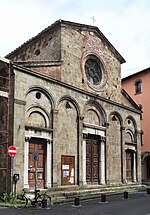San Zeno, Pisa

San Zeno is a church and a former abbey in Pisa, Tuscany, Italy. The church is documented going back to 1029. It was part of a monastery built over pre-existing edifices, and, until the 15th century, it had also a hospital. In the 12th century it was held by the Camaldolese monks. The church has a nave and two aisles. The façade is preceded by a portico supported by pilasters and a central columns. The second row has mullioned windows and decorations with lozenges and small circular windows, with ceramic basins by Islamic masters (11th century; the originals are in the National Museum of San Matteo). The interior has ancient Roman capitals and traces of medieval paintings.
Excerpt from the Wikipedia article San Zeno, Pisa (License: CC BY-SA 3.0, Authors, Images).San Zeno, Pisa
Piazza San Zeno, Pisa San Francesco
Geographical coordinates (GPS) Address Nearby Places Show on map
Geographical coordinates (GPS)
| Latitude | Longitude |
|---|---|
| N 43.723 ° | E 10.407531 ° |
Address
Piazza San Zeno
Piazza San Zeno
56127 Pisa, San Francesco
Tuscany, Italy
Open on Google Maps






